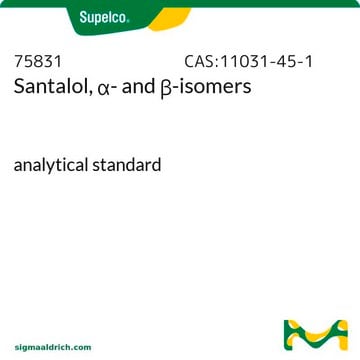50949
Nerol
analytical standard
Synonim(y):
cis-3,7-Dimethyl-2,6-octadien-1-ol, Nerol
About This Item
Polecane produkty
klasa czystości
analytical standard
Poziom jakości
Próba
≥97.0% (GC)
okres trwałości
limited shelf life, expiry date on the label
metody
HPLC: suitable
gas chromatography (GC): suitable
współczynnik refrakcji
n20/D 1.467-1.478
n20/D 1.474 (lit.)
tw
103-105 °C/9 mmHg (lit.)
gęstość
0.876 g/mL at 25 °C (lit.)
Zastosowanie
cleaning products
cosmetics
flavors and fragrances
food and beverages
personal care
format
neat
ciąg SMILES
C\C(C)=C\CC\C(C)=C/CO
InChI
1S/C10H18O/c1-9(2)5-4-6-10(3)7-8-11/h5,7,11H,4,6,8H2,1-3H3/b10-7-
Klucz InChI
GLZPCOQZEFWAFX-YFHOEESVSA-N
Szukasz podobnych produktów? Odwiedź Przewodnik dotyczący porównywania produktów
Powiązane kategorie
Opis ogólny
Zastosowanie
- e-cigarette refill solutions by high performance liquid chromatography-tandem mass spectrometry with electrospray ionization (HPLC-ESI-MS/MS) as well as gas chromatography (GC) coupled to MS/MS operating under the electron impact (EI) mode and multiple reaction monitoring (MRM) mode of detection.
- Honeybush tea (Cyclopia spp.) by headspace solid phase microextraction (HS-SPME) and comprehensive two-dimensional gas chromatography (GC x GC) with flame ionization detection (FID) and a single stage modulator.
- Hanzhong black tea (Camellia sinesis) by solid phase extraction (SPE) and GC coupled to MS as well as olfactometry.
- Wine by liquid-liquid extraction (LLE) and EI-GC-MS with selective ion monitoring (SIM) detection.
Hasło ostrzegawcze
Warning
Zwroty wskazujące rodzaj zagrożenia
Zwroty wskazujące środki ostrożności
Klasyfikacja zagrożeń
Eye Irrit. 2 - Skin Irrit. 2 - Skin Sens. 1B
Kod klasy składowania
10 - Combustible liquids
Klasa zagrożenia wodnego (WGK)
WGK 2
Temperatura zapłonu (°F)
226.0 °F - closed cup
Temperatura zapłonu (°C)
107.78 °C - closed cup
Choose from one of the most recent versions:
Masz już ten produkt?
Dokumenty związane z niedawno zakupionymi produktami zostały zamieszczone w Bibliotece dokumentów.
Klienci oglądali również te produkty
Nasz zespół naukowców ma doświadczenie we wszystkich obszarach badań, w tym w naukach przyrodniczych, materiałoznawstwie, syntezie chemicznej, chromatografii, analityce i wielu innych dziedzinach.
Skontaktuj się z zespołem ds. pomocy technicznej









